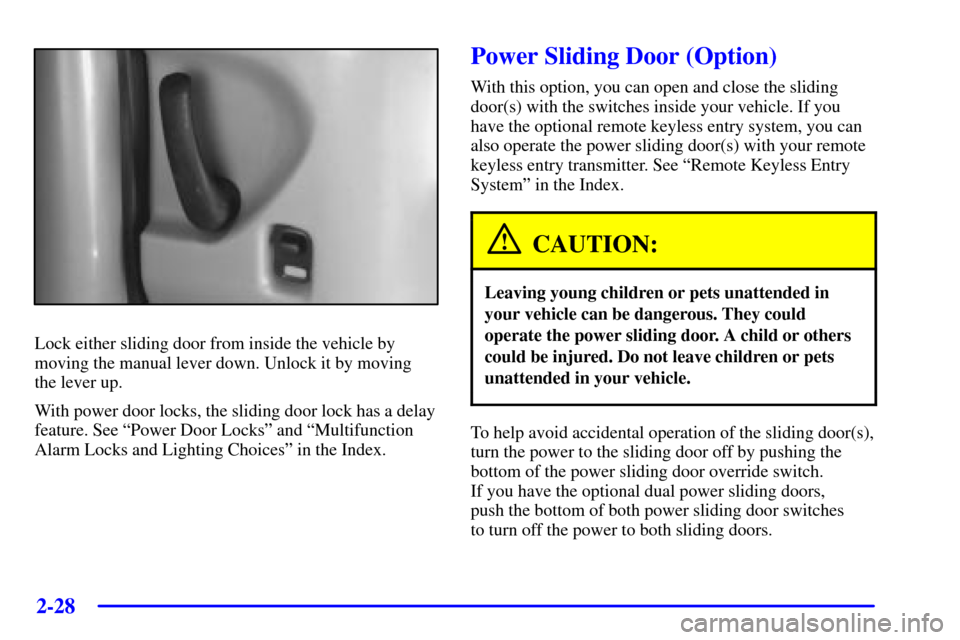Page 99 of 436

2-7
Door Locks
CAUTION:
Unlocked doors can be dangerous.
�Passengers -- especially children -- can
easily open the doors and fall out of a
moving vehicle. When a door is locked,
the handle won't open it. You increase the
chance of being thrown out of the vehicle in
a crash if the doors aren't locked. So, wear
safety belts properly and lock the doors
whenever you drive.
�Young children who get into unlocked
vehicles may be unable to get out. A child
can be overcome by extreme heat and can
suffer permanent injuries or even death
from heat stroke. Always lock your vehicle
whenever you leave it.
�Outsiders can easily enter through an
unlocked door when you slow down or stop
your vehicle. Locking your doors can help
prevent this from happening.
There are several ways to lock and unlock your vehicle.
From the outside, use your key or the optional remote
keyless entry transmitter.
To unlock either front door from the outside with the key,
insert the key and turn it toward the front of the vehicle.
You can lock either front door from the outside with
your key by inserting and turning it toward the rear of
the vehicle.
To lock either front door from the inside, push the
manual lever forward.
To unlock either front door from the inside, pull back on
the manual lever.
Page 120 of 436

2-28
Lock either sliding door from inside the vehicle by
moving the manual lever down. Unlock it by moving
the lever up.
With power door locks, the sliding door lock has a delay
feature. See ªPower Door Locksº and ªMultifunction
Alarm Locks and Lighting Choicesº in the Index.
Power Sliding Door (Option)
With this option, you can open and close the sliding
door(s) with the switches inside your vehicle. If you
have the optional remote keyless entry system, you can
also operate the power sliding door(s) with your remote
keyless entry transmitter. See ªRemote Keyless Entry
Systemº in the Index.
CAUTION:
Leaving young children or pets unattended in
your vehicle can be dangerous. They could
operate the power sliding door. A child or others
could be injured. Do not leave children or pets
unattended in your vehicle.
To help avoid accidental operation of the sliding door(s),
turn the power to the sliding door off by pushing the
bottom of the power sliding door override switch.
If you have the optional dual power sliding doors,
push the bottom of both power sliding door switches
to turn off the power to both sliding doors.
Page 125 of 436

2-33
Sliding Door Security Lock
Your vehicle is equipped with a sliding door security
lock that helps prevent young children or other
passengers from opening the sliding door(s) using
the inside door handle.
The security lock lever is located on the inside of the
sliding door(s), on the front edge of the door. To access
the lever, open the sliding door. Use the security lock
label on the edge of the door as a guide.
To use the security lock,
move the security lock
lever all the way up
and close the door from
the outside.If your vehicle has the optional power sliding door(s),
you can override the security lock by pressing either
power door switch when the power sliding door override
switch is turned off. When the power sliding door
override switch is turned on, the power sliding door(s)
cannot be opened from the inside when the sliding door
security lock is in use.
If you want to open the sliding door when the security
lock is on, unlock and open the door from the outside.
You should let adults and older children know how the
security lock works, and how to cancel the lock. If you
don't, adults or older children who ride in the rear won't
be able to open the sliding door from the inside when
the security lock feature is in use.
Page 269 of 436

4-12 Steering in Emergencies
There are times when steering can be more effective
than braking. For example, you come over a hill and
find a truck stopped in your lane, or a car suddenly
pulls out from nowhere, or a child darts out from
between parked cars and stops right in front of you.
You can avoid these problems by braking
-- if you can
stop in time. But sometimes you can't; there isn't room.
That's the time for evasive action
-- steering around
the problem.
Your vehicle can perform very well in emergencies
like these. First apply your brakes. See ªBraking in
Emergenciesº earlier in this section. It is better to
remove as much speed as you can from a possible
collision. Then steer around the problem, to the left
or right depending on the space available.
An emergency like this requires close attention and a
quick decision. If you are holding the steering wheel at
the recommended 9 and 3 o'clock positions, you can
turn it a full 180 degrees very quickly without removing
either hand. But you have to act fast, steer quickly, and
just as quickly straighten the wheel once you have
avoided the object.
The fact that such emergency situations are always
possible is a good reason to practice defensive driving
at all times and wear safety belts properly.